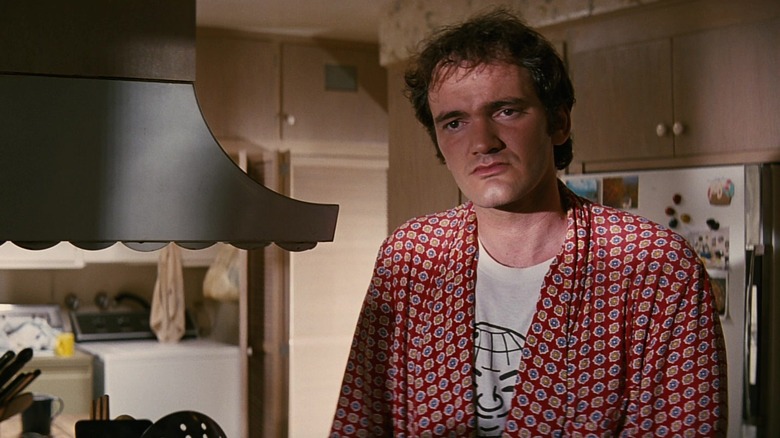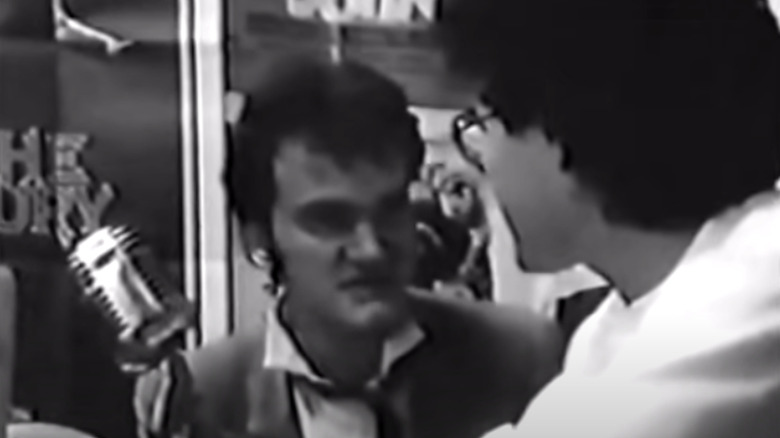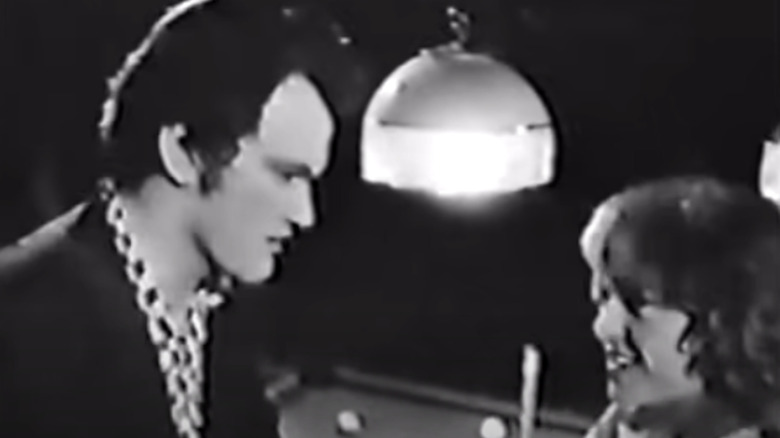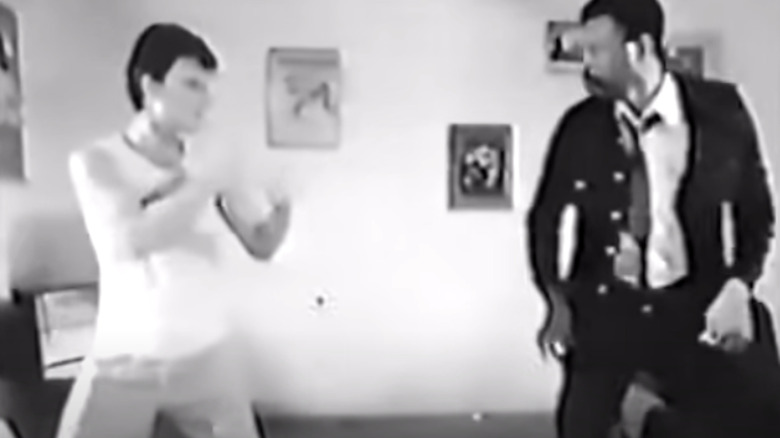Why You'll Never See Quentin Tarantino's First Feature Film
We may receive a commission on purchases made from links.
When "Once Upon a Time in Hollywood" was released to theaters in 2019, it was promoted as "The 9th Film by Quentin Tarantino." Technically, this is true. Though "Kill Bill" was split into two volumes due to its 247-minute runtime, it is one complete story (one that, hopefully, will someday be available to the public in its intended, un-compromised form). Still, there is one intriguing what-if that could bump Tarantino up into 10 completed features — one that presaged his pop-culture cuisinart sensibility while displaying, in the crudest of forms, his formal daring.
The film is called "My Best Friend's Birthday," and only 36 minutes remain of what was once a 70-minute shoestring-budget indie comedy that, had Tarantino had been able to splice his footage into a coherent story, might've been able to land a competition slot at the Sundance Film Festival. Because, despite its ultra lo-fi aesthetic, it's got a hyper-referential swagger that plays like Jean-Luc Godard on a cocaine binge. There was nothing remotely like it at the time.
What happened to the 70-minute cut? There is the legend, and there is the unsexy truth. Guess which one Tarantino prefers.
How Roscoe P. Coltrane (kind of) inspired Tarantino to become a filmmaker
"My Best Friend's Birthday" began as a 40-page script by Craig Hamman, an aspiring actor and assistant fight coordinator eager to generate his own material. Hamman took acting classes from James Best, a veteran of Hollywood Westerns who found TV immortality as oafish Sheriff Roscoe P. Coltrane on CBS' "The Dukes of Hazzard," and soon became friends with a quirky classmate whose drive to become an actor was rooted in pure cinephilia.
Quentin Tarantino did not impress their teacher as a performer, but everyone in the class was blown away by the young man's unabashed love for movies. Eventually, Tarantino began performing his own material, which prompted Best to tell his pupil, "You're a lousy actor. You should take up writing." Hellbent on breaking into the business, Tarantino teamed with Hamman to expand his script into an 80-page feature, which soon became a nervy rom-com peppered with extraneous asides and random bits of violence.
The plot, such as it is, of "My Best Friend's Birthday" ostensibly centers on an obnoxious radio DJ's attempt to cheer up his just-dumped buddy. His brilliant plan is to hire a sweet-natured call girl to surprise the forlorn Mickey at his apartment. Along the way, the excitable DJ engages in pop-culture laden digressions with random people.
The narrative wasn't much, but no one could deny that, on the page, the rapid-fire dialogue was invigoratingly distinct and occasionally witty (when it wasn't hopelessly juvenile). So Hamman and Tarantino, who was barely eking by as a video store clerk at the time, cobbled a cast and crew together, borrowed a 16mm camera from schlockmeister Fred Olen Ray, and, with a paltry $5,000, made ... something. But was it something worth watching?
Quentin Tarantino's Clerks?
We may never know because only a roughly stitched-together 36-minute collection of footage remains. For years, the 70-minute cut of "My Best Friend's Birthday" was declared lost due to a lab fire. But in Andrew J. Rausch's oral history "My Best Friend's Birthday: The Making of a Quentin Tarantino Film" (a must-read for fans of the filmmaker), Tarantino confessed that this was a BS story that he declined to correct because he liked the mystery of it. In reality, Tarantino couldn't find a workable cut in the edit, and abandoned the film altogether.
Judging from the 36-minute reel currently available on YouTube (which, as you can tell from the screengrabs used here, was uploaded from an nth-generation VHS rip), Tarantino might've had an early "Clerks" on his hands. The film employed four cinematographers throughout its production (including Tarantino's co-worker Roger Avary), and thus lacks a cohesive visual style. As a director, Tarantino veers from play-it-safe static shots and surprisingly ambitious oners (like the high-angle dolly shot in the pool hall). As the motor-mouthed DJ Clarence, who browbeats people with his inflexible opinions on, among other things, rockabilly music, he is terrible.
A cinematic genius in his pupal stage
But there are glimmers of his soon-to-blossom genius in this 1987 oddity. The scene where Clarence procures the services of call girl Misty (Crystal Shaw) pops with witty exchanges ("What do you usually pay," she asks, to which he responds "The going rate is what I usually pay"). Misty is very clearly a rough sketch of what would become Patricia Arquette's "Alabama" in "True Romance," while Clarence spouts amusingly unprompted observations that would sound far less grating from Christian Slater (e.g. "If I ever had to f*** a guy, I'd f*** Elvis"). The soundtrack is loaded with deep-cut needle-drops (like The Creatures' cover of the 1960s jazz standard "Right Now"), and there's even kung-fu (courtesy of martial artist Hamann)!
Mostly, though, what's left of the film feels like Tarantino's approximation of an early Woody Allen comedy with a dash of Jim Jarmusch-inspired postmodernism. I also like Avary's assessment that it's "a sloppy 'She's Gotta Have It.'" As for Tarantino, he looks back on the experience fondly. "It was a lovely time in my life," he told Rausch. "It was my film school."
If nothing else, it was a first-rate education. Three years after giving up on "My Best Friend's Birthday," Tarantino's dialogue-heavy script about a bungled diamond heist would find its way to Harvey Keitel. The finished product, "Reservoir Dogs," would take the indie world by storm at the 1992 Sundance Film Festival, and establish Tarantino as the voice of the video-store generation. And this would've never happened if he hadn't given himself the license to fail — though burying that undisciplined first effort was probably a savvy career move. If critics could've judged "Reservoir Dogs" against "My Best Friend's Birthday," they might've been less thunderstruck by the former.



